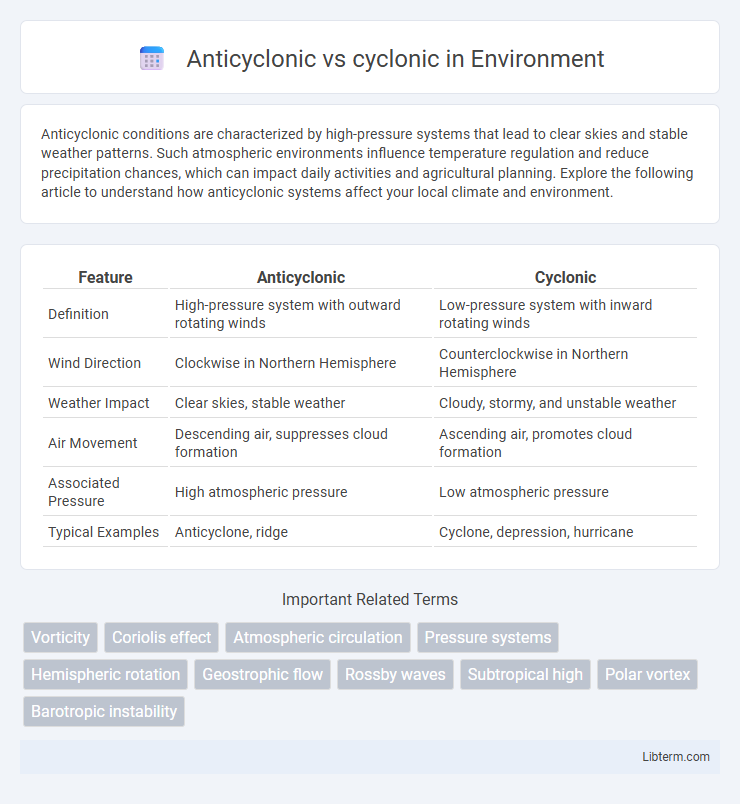Anticyclonic conditions are characterized by high-pressure systems that lead to clear skies and stable weather patterns. Such atmospheric environments influence temperature regulation and reduce precipitation chances, which can impact daily activities and agricultural planning. Explore the following article to understand how anticyclonic systems affect your local climate and environment.
Table of Comparison
| Feature | Anticyclonic | Cyclonic |
|---|---|---|
| Definition | High-pressure system with outward rotating winds | Low-pressure system with inward rotating winds |
| Wind Direction | Clockwise in Northern Hemisphere | Counterclockwise in Northern Hemisphere |
| Weather Impact | Clear skies, stable weather | Cloudy, stormy, and unstable weather |
| Air Movement | Descending air, suppresses cloud formation | Ascending air, promotes cloud formation |
| Associated Pressure | High atmospheric pressure | Low atmospheric pressure |
| Typical Examples | Anticyclone, ridge | Cyclone, depression, hurricane |
Understanding Cyclonic and Anticyclonic Systems
Cyclonic systems are characterized by low-pressure centers with inward spiraling winds that rotate counterclockwise in the Northern Hemisphere and clockwise in the Southern Hemisphere, leading to cloud formation and precipitation. Anticyclonic systems feature high-pressure centers with outward spiraling winds rotating clockwise in the Northern Hemisphere and counterclockwise in the Southern Hemisphere, typically resulting in clear skies and stable weather conditions. Understanding the dynamics of these pressure systems is crucial for accurate weather forecasting and climate analysis.
Defining Cyclonic Motion
Cyclonic motion refers to the counterclockwise rotation of air around a low-pressure system in the Northern Hemisphere, characterized by inward spiraling winds and rising air. This dynamic typically leads to cloud formation and potential precipitation due to the convergence and uplift of moist air. The opposite, anticyclonic motion, involves clockwise rotation around a high-pressure system, featuring descending air and generally clear, stable weather conditions.
Defining Anticyclonic Motion
Anticyclonic motion refers to the clockwise rotation of air in the Northern Hemisphere or counterclockwise in the Southern Hemisphere, characterized by high-pressure systems where air descends and diverges at the surface. This motion contrasts with cyclonic motion, which involves counterclockwise rotation in the Northern Hemisphere or clockwise in the Southern Hemisphere, associated with low-pressure systems and ascending air that converges at the surface. Anticyclonic conditions typically bring clear skies and stable weather due to the subsiding, dry air within the high-pressure area.
Atmospheric Pressure Differences
Anticyclonic systems are characterized by high atmospheric pressure where air diverges and descends, creating clear skies and stable weather conditions. Cyclonic systems feature low atmospheric pressure with rising air that converges inward, resulting in cloud formation and often stormy weather. The pressure gradient between these systems significantly influences wind patterns and weather dynamics.
Wind Patterns and Directions
Anticyclonic wind patterns rotate clockwise in the Northern Hemisphere and counterclockwise in the Southern Hemisphere, characterized by descending air and generally calm, dry conditions. Cyclonic wind patterns rotate counterclockwise in the Northern Hemisphere and clockwise in the Southern Hemisphere, associated with rising air, cloud formation, and precipitation. These differing rotation directions result from the Coriolis effect influencing pressure systems, with anticyclones linked to high-pressure areas and cyclones to low-pressure systems.
Weather Impacts of Cyclonic Systems
Cyclonic systems, characterized by low-pressure centers and inward spiraling winds, often lead to severe weather events such as heavy rainfall, thunderstorms, and strong winds. These weather impacts frequently cause flooding, property damage, and disruptions in transportation, particularly in coastal and tropical regions prone to hurricanes and tropical cyclones. In contrast, anticyclonic systems typically bring stable, clear skies and calmer weather conditions, with high pressure inhibiting cloud formation and precipitation.
Weather Impacts of Anticyclonic Systems
Anticyclonic systems, characterized by high atmospheric pressure and clockwise air circulation in the Northern Hemisphere, typically bring clear skies, stable weather, and reduced precipitation. These conditions result in prolonged dry spells, increased risk of droughts, and potential heatwaves due to subsidence and warming of descending air. Unlike cyclonic systems associated with storms and rain, anticyclones suppress cloud formation and limit severe weather events.
Global Distribution and Occurrence
Anticyclonic systems predominantly occur in subtropical high-pressure zones, such as the North Atlantic High and the South Pacific High, influencing weather patterns by promoting clear skies and stable conditions globally. Cyclonic systems are more frequent along mid-latitude storm tracks and tropical regions, particularly in the North Atlantic hurricane basin and Western Pacific typhoon regions, where they drive intense weather activities like storms and heavy precipitation. The distribution of these systems is shaped by Earth's rotation and atmospheric circulation, resulting in distinct seasonal and geographical occurrence patterns.
Cyclonic vs Anticyclonic Impacts on Climate
Cyclonic systems, characterized by low-pressure centers and counterclockwise wind flow in the Northern Hemisphere, typically bring increased precipitation, storms, and cooler temperatures, influencing regional weather patterns and contributing to climate variability. Anticyclonic systems, associated with high-pressure centers and clockwise wind circulation in the Northern Hemisphere, generally cause clear skies, dry conditions, and warmer temperatures, leading to prolonged droughts or heatwaves that impact ecosystems and agriculture. Understanding the distinct climatic impacts of cyclonic and anticyclonic phenomena aids in forecasting extreme weather events and assessing their implications for climate resilience and adaptation strategies.
Practical Implications for Weather Forecasting
Anticyclonic systems, characterized by high-pressure centers and clockwise wind rotation in the Northern Hemisphere, typically bring stable, clear weather conditions ideal for accurate short-term forecasting. Cyclonic systems, with low-pressure centers and counterclockwise wind rotation, are associated with stormy weather and precipitation, posing challenges in predicting rapid changes and localized severe events. Understanding the dynamics of anticyclonic versus cyclonic patterns enhances meteorologists' ability to anticipate weather developments, improving disaster preparedness and resource allocation.
Anticyclonic Infographic

 libterm.com
libterm.com